Getting Started with Xamarin.iOS DataGrid (SfDataGrid)
1 Mar 202214 minutes to read
This section provides a quick overview for working with SfDataGrid for Xamarin.iOS. You will walk through the entire process of creating a real world SfDataGrid.
Assembly deployment
After installing Essential Studio for Xamarin, you can find all the required assemblies in the installation folders,
{Syncfusion Essential Studio Installed location}\Essential Studio\25.1.35\Xamarin\lib
Eg: C:\Program Files (x86)\Syncfusion\Essential Studio\25.1.35\Xamarin\lib
NOTE
Assemblies can be found in unzipped package location in Mac
NuGet configuration
To install the required NuGet for the SfDataGrid control in the application, configure the NuGet packages of the Syncfusion components.
Refer to the following KB to configure the NuGet packages of the Syncfusion components:
How to configure package source and install Syncfusion NuGet packages in an existing project?
The following NuGet package should be installed to use the SfDataGrid control in the application.
| Project | Required package |
|---|---|
| Xamarin.iOS | Syncfusion.Xamarin.SfDataGrid.iOS |
Adding SfDataGrid Reference
Syncfusion Xamarin components are available in nuget.org. To add SfDataGrid to your project, open the NuGet package manager in Visual Studio, and search for Syncfusion.Xamarin.SfDataGrid.IOS, and then install it.

To know more about obtaining our components, refer to this link. Also, if you prefer to manually refer the assemblies instead of NuGet, refer the list of assemblies mentioned in the table below.
| Project | Required assemblies |
|---|---|
| Xamarin.iOS | Syncfusion.Linq.iOS.dll Syncfusion.SfDataGrid.iOS.dll Syncfusion.GridCommon.Portable.dll Syncfusion.SfNumericTextBox.iOS.dll |
To export the SfDataGrid to Excel and PDF formats, search for Syncfusion.Xamarin.SfGridConverter.IOS in the NuGet package manager, and then install it.
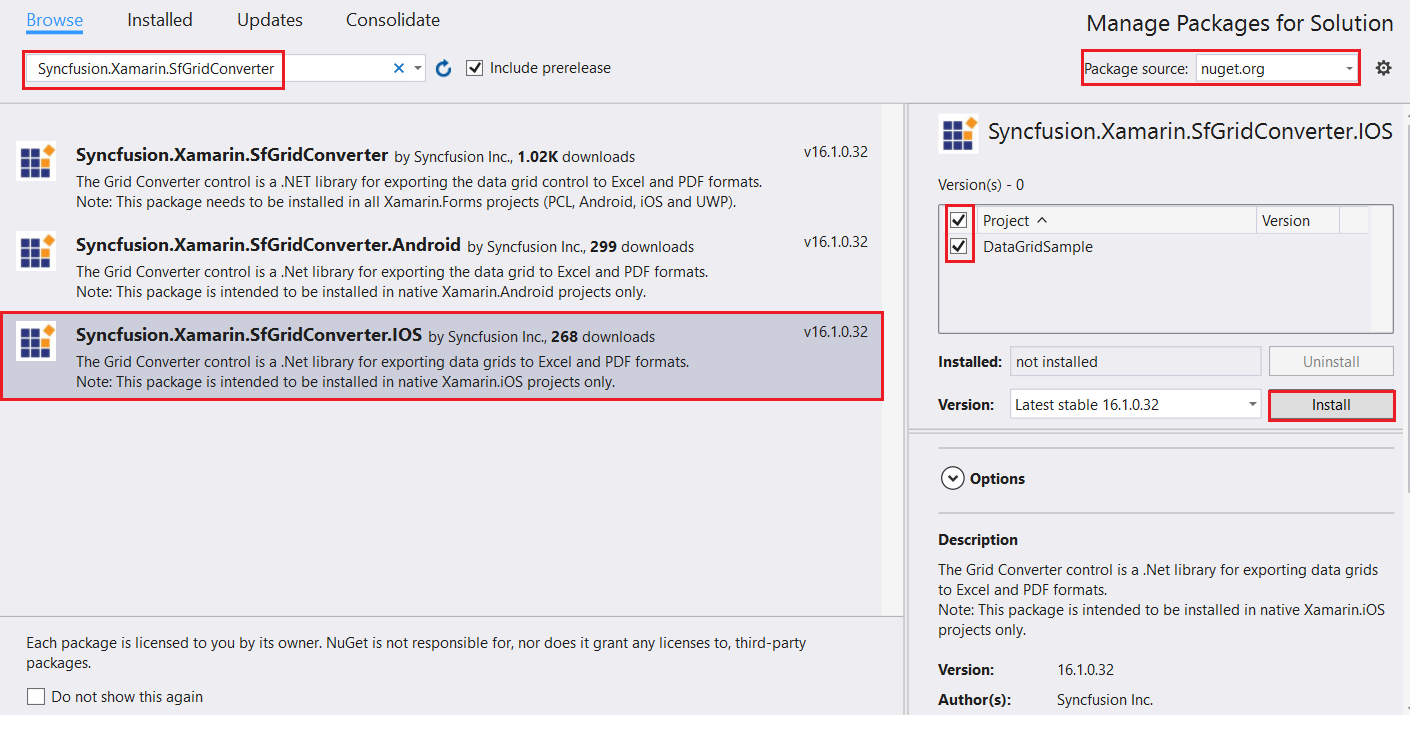
If you prefer to manually refer the assemblies instead of NuGet, refer the list of assemblies mentioned in the table below.
| Project | Required assemblies |
|---|---|
| Xamarin.iOS | Syncfusion.SfGridConverter.iOS.dll pcl\Syncfusion.Compression.Portable.dll pcl\Syncfusion.Pdf.Portable.dll pcl\Syncfusion.XlsIO.Portable.dll |
IMPORTANT
Starting with v16.2.0.x, if you reference Syncfusion assemblies from trial setup or from the NuGet feed, you also have to include a license key in your projects. Please refer to this link to know about registering Syncfusion license key in your Xamarin application to use our components.
Create a simple SfDataGrid
This section explains how to create a SfDataGrid and configure it. The SfDataGrid control can be configured entirely in C# code or using story board. This is how the final output will look like on iOS devices.
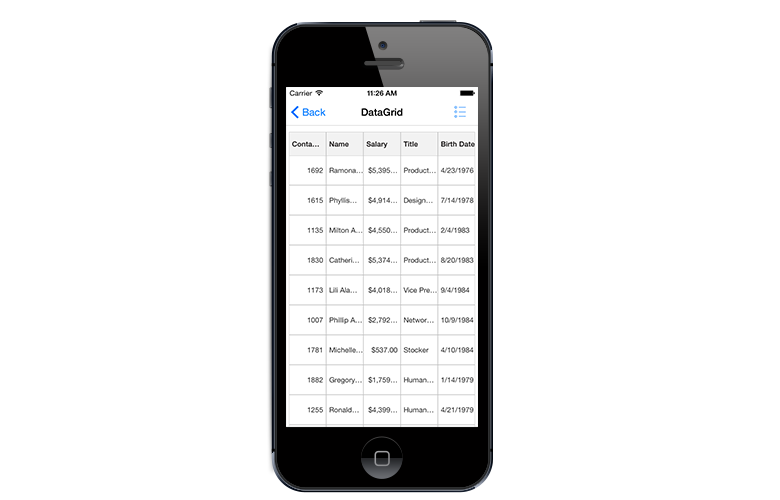
You can download the entire source code of this demo for Xamarin.iOS from here.
In this walk through, you will create a new application that contains the SfDataGrid which includes the below topics.
- Creating the project
- Adding SfDataGrid in Xamarin.iOS
- Create data model
- Binding data
- Defining columns
- Sorting
- Grouping
- Selection
- Editing
Creating the project
Create a new iOS application in Xamarin Studio or Visual Studio for Xamarin.iOS.
Adding SfDataGrid in Xamarin.iOS using story board
- Add a new story board inside the project.
- Drag the SfDataGrid control from toolbox and drop it into the story board. Preview for SfDataGrid will be shown.
- Open the properties window of SfDataGrid and set the required properties.
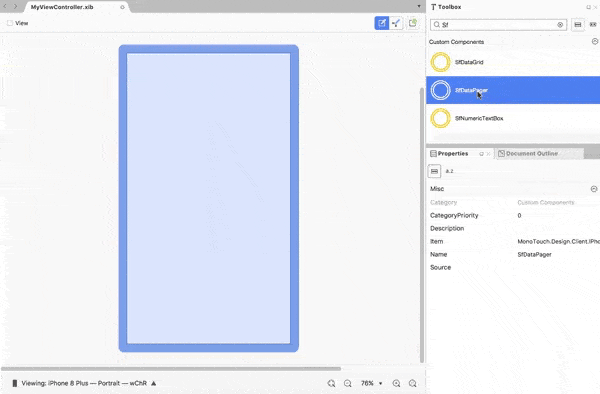
Setting the SfDataGrid properties in story board
Set the identity name and required properties for SfDataGrid in story board.

Set the identity name and required properties for SfDataPager in story board.
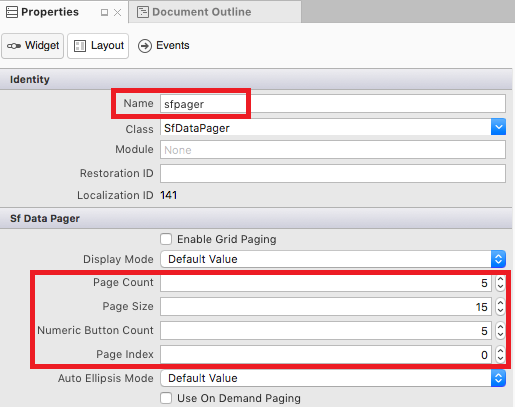
namespace Grid
{
public partial class MyViewController : UIViewController
{
ViewModel viewModel;
public MyViewController() : base("MyViewController",null)
{
}
public override void ViewDidLoad()
{
base.ViewDidLoad();
// Perform any additional setup loading the view, typically from a nib.
viewModel = new ViewModel();
sfPager.Source = viewModel.OrdersInfo;
sfGrid.ItemSource = sfPager.PagedSource;
}
public override void DidReceiveMemoryWarning()
{
base.DidReceiveMemoryWarning();
// Release any cached data, images, etc that aren't in use.
}
}
}You can download the entire source code of this sample here.
Refer to this link to know the properties that can be configured using story board for SfDataGrid.
Adding SfDataGrid in Xamarin.iOS using C# code
-
Add the required assembly references to the project as discussed in the Assembly deployment section.
-
Import SfDataGrid control namespace Syncfusion.SfDataGrid.
-
Create an instance of SfDataGrid control and add as a SubView to a UIViewController.
using Syncfusion.SfDataGrid;
public partial class GettingStartedViewController : UIViewController
{
SfDataGrid dataGrid;
static bool UserInterfaceIdiomIsPhone {
get { return UIDevice.CurrentDevice.UserInterfaceIdiom == UIUserInterfaceIdiom.Phone; }
}
public GettingStartedViewController ()
: base (UserInterfaceIdiomIsPhone ? "GettingStartedViewController_iPhone" : "GettingStartedViewController_iPad", null)
{
dataGrid = new SfDataGrid ();
dataGrid.HeaderRowHeight = 45;
dataGrid.RowHeight = 45;
}
public override void ViewDidLoad ()
{
base.ViewDidLoad ();
dataGrid.Frame = new CGRect (0, 0, View.Frame.Width, View.Frame.Height);
View.AddSubview (dataGrid);
}
}You can also set HeaderRowHeight and RowHeight for SfDataGrid using story board.
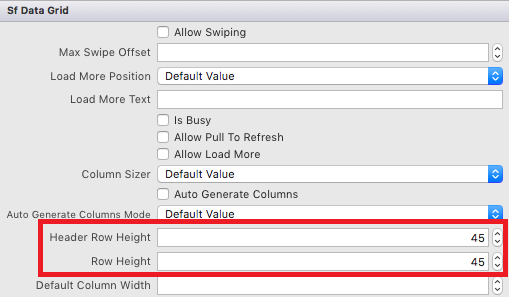
Run the application to render the following output.
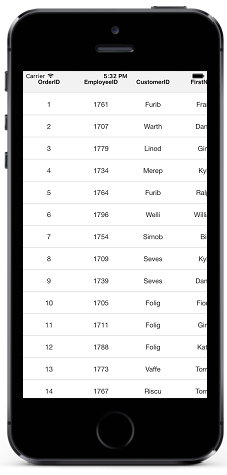
The Frame is used to arrange a view in Xamarin.iOS. By default a view in Xamarin.iOS will be arranged without any padding from the title bar. Hence the content of the arranged view will overlap with the title bar if the top position of its Frame is set as 0.
To overcome the above problem, the top position of the view’s Frame has to be customized accordingly to position the view below the title bar in iOS. Refer the below code example in which the top position of the SfDataGrid’s Frame is set to 30 to overcome the problem.
public override void ViewDidLoad ()
{
base.ViewDidLoad ();
dataGrid.Frame = new CGRect (0, 30, View.Frame.Width, View.Frame.Height);
View.AddSubview (dataGrid);
}Run the application with the above code to render the following output.

Create DataModel for the SfDataGrid
SfDataGrid is a data-bound control. Hence you must create a data model to bind it to the control.
Create a simple data source as shown in the following code example in a new class file and save it as OrderInfo.cs file.
public class OrderInfo
{
private int orderID;
private string customerID;
private string customer;
private string shipCity;
private string shipCountry;
public int OrderID {
get { return orderID; }
set { this.orderID = value; }
}
public string CustomerID {
get { return customerID; }
set { this.customerID = value; }
}
public string ShipCountry {
get { return shipCountry; }
set { this.shipCountry = value; }
}
public string Customer {
get { return this.customer; }
set { this.customer = value; }
}
public string ShipCity {
get { return shipCity; }
set { this.shipCity = value; }
}
public OrderInfo (int orderId, string customerId, string country, string customer, string shipCity)
{
this.OrderID = orderId;
this.CustomerID = customerId;
this.Customer = customer;
this.ShipCountry = country;
this.ShipCity = shipCity;
}
}NOTE
If you want your data model to respond to property changes, then implement
INotifyPropertyChangedinterface in your model class
Create a model repository class with OrderInfo collection property initialized with required number of data objects in a new class file as shown in the following code example and save it as OrderInfoRepository.cs file.
public class OrderInfoRepository
{
private ObservableCollection<OrderInfo> orderInfo;
public ObservableCollection<OrderInfo> OrderInfoCollection {
get { return orderInfo; }
set { this.orderInfo = value; }
}
public OrderInfoRepository ()
{
orderInfo = new ObservableCollection<OrderInfo> ();
this.GenerateOrders ();
}
private void GenerateOrders ()
{
orderInfo.Add (new OrderInfo (1001, "Maria Anders", "Germany", "ALFKI", "Berlin"));
orderInfo.Add (new OrderInfo (1002, "Ana Trujillo", "Mexico", "ANATR", "Mexico D.F."));
orderInfo.Add (new OrderInfo (1003, "Ant Fuller", "Mexico", "ANTON", "Mexico D.F."));
orderInfo.Add (new OrderInfo (1004, "Thomas Hardy", "UK", "AROUT", "London"));
orderInfo.Add (new OrderInfo (1005, "Tim Adams", "Sweden", "BERGS", "Lula"));
orderInfo.Add (new OrderInfo (1006, "Hanna Moos", "Germany", "BLAUS", "Mannheim"));
orderInfo.Add (new OrderInfo (1007, "Andrew Fuller", "France", "BLONP", "Strasbourg"));
orderInfo.Add (new OrderInfo (1008, "Martin King", "Spain", "BOLID", "Madrid"));
orderInfo.Add (new OrderInfo (1009, "Lenny Lin", "France", "BONAP", "Marseilles"));
orderInfo.Add (new OrderInfo (1010, "John Carter", "Canada", "BOTTM", "Tsawassen"));
orderInfo.Add (new OrderInfo (1011, "Martin King", "UK", "AROUT", "London"));
orderInfo.Add (new OrderInfo (1012, "Anne Wilson", "Germany", "BLAUS", "Mannheim"));
orderInfo.Add (new OrderInfo (1013, "Hanna Kyle", "France", "BLONP", "Strasbourg"));
orderInfo.Add (new OrderInfo (1014, "Gina Irene", "UK", "AROUT", "London"));
}
}Binding data to SfDataGrid
In order to bind the data source of the SfDataGrid, set the SfDataGrid.ItemsSource property as shown below. You can bind the data source of the SfDataGrid as follows.
The following code example binds the collection created in previous step to SfDataGrid.ItemsSource property.
OrderInfoRepository viewModel = new OrderInfoRepository ();
dataGrid.ItemsSource = viewModel.OrderInfoCollection;Now run the application to render the following output.

Defining Columns
By default, the SfDataGrid automatically creates columns for all the properties in the data source. The type of the column generated depends on the type of data in the column. When the columns are auto-generated, you can handle the SfDataGrid.AutoGeneratingColumn event to customize or cancel the columns before they are added to the Columns collection in SfDataGrid.
You can also define the columns manually by setting the SfDataGrid.AutoGenerateColumns property to false and by adding the GridColumn objects to the SfDataGrid.Columns collection. The following code example illustrates how this can be done.
dataGrid.AutoGenerateColumns = false;
GridTextColumn orderIdColumn = new GridTextColumn ();
orderIdColumn.MappingName = "OrderID";
orderIdColumn.HeaderText = "Order ID";
GridTextColumn customerIdColumn = new GridTextColumn ();
customerIdColumn.MappingName = "CustomerID";
customerIdColumn.HeaderText = "Customer ID";
GridTextColumn customerColumn = new GridTextColumn ();
customerColumn.MappingName = "Customer";
customerColumn.HeaderText = "Customer";
GridTextColumn countryColumn = new GridTextColumn ();
countryColumn.MappingName = "ShipCountry";
countryColumn.HeaderText = "Ship Country";
dataGrid.Columns.Add (orderIdColumn);
dataGrid.Columns.Add (customerIdColumn);
dataGrid.Columns.Add (customerColumn);
dataGrid.Columns.Add (countryColumn);Sorting
SfDataGrid allows you to apply sorting on its data by setting the SfDataGrid.AllowSorting property to true.
You can also set the sorting for SfDataGrid using story board.

dataGrid.AllowSorting = true;Run the application and touch the header cell to sort the data and the following output will be displayed.
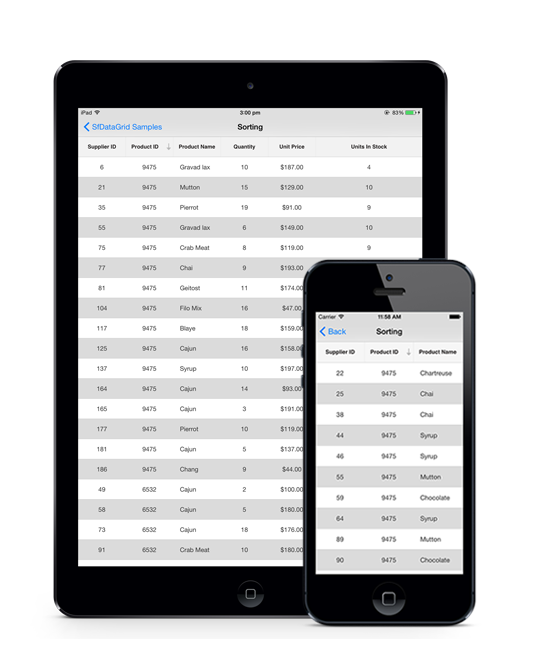
You can also configure sorting by adding the column to the SfDataGrid.SortColumnDescriptions collection as below.
dataGrid.SortColumnDescriptions.Add (new SortColumnDescription () { ColumnName = "CustomerID" });Grouping
SfDataGrid allows you to group a column by adding the column to the SfDataGrid.GroupColumnDescriptions collection as shown below.
dataGrid.GroupColumnDescriptions.Add (new GroupColumnDescription () { ColumnName = "ShipCountry" });Run the application to render the following output.
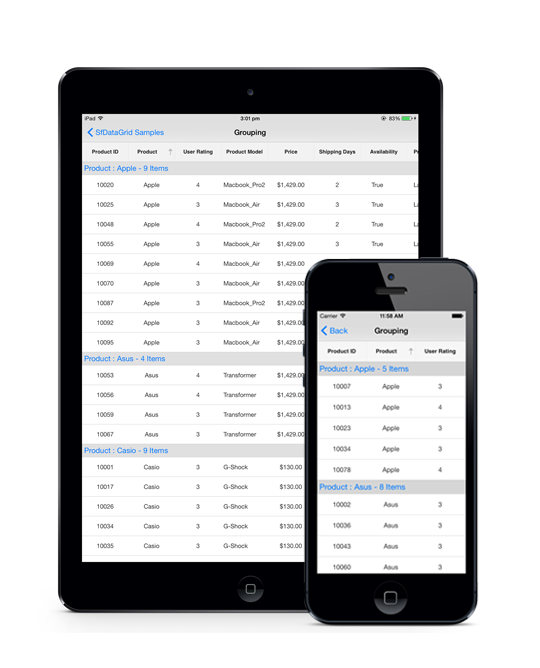
Selection
SfDataGrid allows you to select the row/rows by setting the SfDataGrid.SelectionMode property. You can set the SfDataGrid.SelectionMode property to single, multiple, single deselect or none based on your requirements. Information about the row/rows selected can be tracked using SfDataGrid.SelectedItem and SfDataGrid.SelectedItems properties.
Loading SfDataGrid with customized height and width
SfDataGrid can be loaded with specific height and width by specifying the height and width of the SfDataGrid.Frame property.
To load SfDataGrid with specific height and width, follow the code example:
public override void ViewDidLayoutSubviews()
{
dataGrid.Frame = new CGRect(85, 130, 200, 380);
base.ViewDidLayoutSubviews();
}You can also set the custom height and width to SfDataGrid using story board.
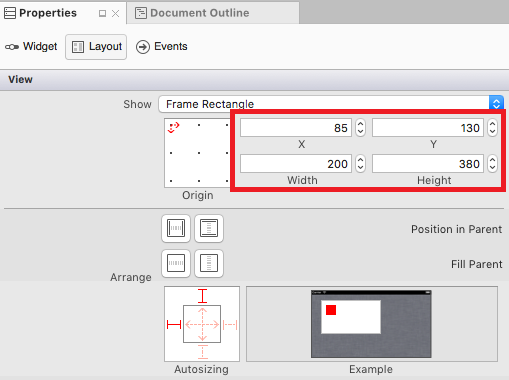
The following screenshot shows how the SfDataGrid is loaded with specific height and width:
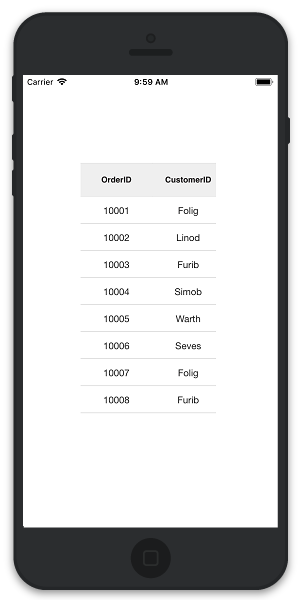
Properties configured using story board
| Properties | Attribute Name |
|---|---|
| AlternatingRowColor | Alternating Row Color |
| AlternationCount | Alternation Count |
| AllowPullToRefresh | Allow Pull To Refresh |
| AllowLoadMore | Allow Load More |
| AllowEditing | Allow Editing |
| AllowSorting | Allow Sorting |
| AllowMultiSorting | Allow Multi Sorting |
| AllowTriStateSorting | Allow Tri State Sorting |
| AllowDraggingColumn | Allow Dragging Column |
| AllowDraggingRow | Allow Dragging Row |
| AllowResizingColumn | Allow Resizing Column |
| AutoGenerateColumns | Auto Generate Columns |
| AutoGenerateColumnsMode | Auto Generate Columns Mode |
| AutoEllipsisMode | Auto Ellipsis Mode |
| CellBorderStyle | Cell Border Style |
| ColumnSizer | Column Sizer |
| DefaultColumnWidth | Default Column Width |
| DataFetchSize | Data Fetch Size |
| EditTapAction | Edit Tap Action |
| EditorSelectionBehavior | Editor Selection Behavior |
| EnableDataVirtualization | Enable Data Virtualization |
| FrozenRowsCount | Frozen Rows Count |
| FrozenColumnsCount | Frozen Columns Count |
| GroupCaptionTextFormat | Group Caption Text Format |
| GroupingMode | Grouping Mode |
| HeaderRowHeight | Header Row Height |
| IndentColumnWidth | Indent Column Width |
| Orientation | Orientation |
| NumericButtonBackground | Numeric Button Background |
| NumericButtonCount | Numeric Button Count |
| PageCount | Page Count |
| PageSize | Page Size |
| ResizingMode | Resizing Mode |
| RowHeight | Row Height |
| RowHeaderWidth | Row Header Width |
| ScrollingMode | Scrolling Mode |
| SelectionForeground | Selection Foreground |
| SelectionMode | Selection Mode |
| SelectedIndex | Selected Index |
| ShowRowHeader | Show Row Header |
| ShowColumnWhenGrouped | Show Column When Grouped |
| SortTapAction | Sort Tap Action |
| UseOnDemandPaging | Use On Demand Paging |